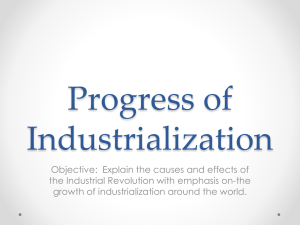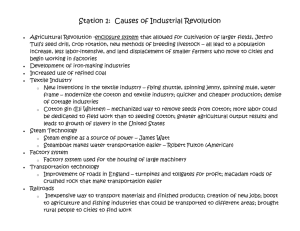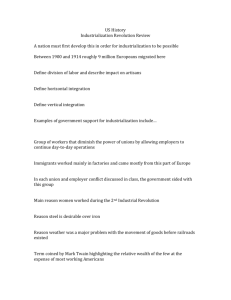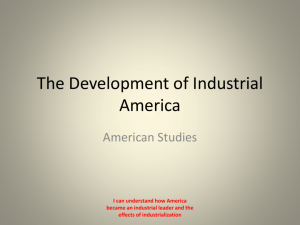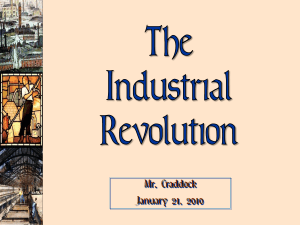Industrial Society
advertisement
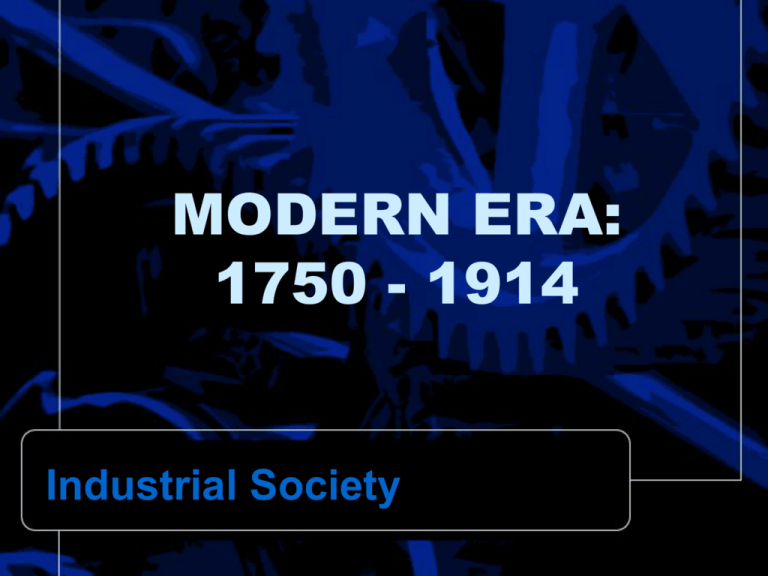
MODERN ERA: 1750 - 1914 Industrial Society FOUNDATIONS OF INDUSTRIALIZATION • Coal critical to the early industrialization of Britain – • Overseas colonies provided raw materials, capital – – • Burned coal, which drove a piston, which turned a wheel Widespread use by 1800 meant increased productivity, cheaper prices Iron and steel also important industries, with continual refinement – – • John Kay invented the flying shuttle, 1733 Edmund Cartwright invented a water-driven power loom, 1785 James Watt's steam engine, 1765 – – • Plantations in the Americas provided sugar and cotton Colonies also became markets for British manufactured goods Demand for cheap cotton spurred mechanization of cotton industry – – • Abundant, accessible coal reserves in Britain Coke (purified coal) replaced charcoal as principal fuel Bessemer converter (1856) made cheaper, stronger steel Transportation improved with steam engines and improved steel – – – George Stephenson invented the first steam-powered locomotive, 1815 Steamships began to replace sailing ships in the mid-nineteenth century Railroads and steamships lowered transportation costs IMAGES OF INVENTION INDUSTRIAL CAUSE & EFFECT SPINNING <-------------------------------------> WEAVING (EX: Spinning Jenny) + (EX: Flying shuttle) Machines become heavier, thus Extra power is needed, thus Watermills, steam engine invented, thus Emergence of factory system, replacing cottage industry; Because production must be concentrated near the power source, and machines become too expensive to be owned by workers, thus Profound social transformations, thus Urban influx, crowding, unprecedented social problems thus Workers organize, government passes laws and reforms, unions begin to arise FACTORY SYSTEM • The factory – – – – • Gradually replaced the putting-out system Factory system required division of labor Each worker performed a single task Work discipline, close supervision Working conditions often harsh – Workers lost status • • – – – • Not skilled Just wage earners Harsh work discipline Fast pace of work Frequent accidents Industrial protest – – Saboteurs Luddites in England • – Struck against mills and destroyed machines, 1811 and 1816 Weaver rebellions in Germany against power looms SPREAD OF INDUSTRIALIZATION • British industrial monopoly – – • 1750 to 1800 Forbade immigration of skilled workers Continental System of Napoleon – • Abolished internal trade barriers in western Europe, sped up process Belgium, France – • Belgium was first as it most resembled England, closest ports Germany – – – • Bismarck sponsored heavy industry, arms, shipping Built railroads to move German army around, benefiting commerce Rails required steel, coal The United States – – Slow to start: few laborers, little capital Cotton and Textiles began revolution • • • – – British craftsmen started cotton textile industry in New England, 1820s Southern cotton was going to England, diverted to New England factories New England most resembled Old England conditions Civil War led to explosion of steel, iron, armaments, clothing, food production Rail networks developed in 1860s • • Integrated various regions of United States Facilitated export markets, development of ports MAPPING THE REVOLUTION INDUSTRIAL CAPITALISM • Mass production – – Provided cheaper goods for all classes of society Eli Whitney • • – Henry Ford • • • Mass production of interchangeable parts for firearms Cotton Gin made cotton harvesting, production cheaper Introduced assembly line Applied to automobile production Industrialization – – • Expensive Required large capital investment Structural Changes of Industry – • Large-scale corporations with investors Monopolies, trusts, and cartels – – Competitive associations Vertical organization (Monopoly) • • • – Horizontal organization (Trusts or cartel) • – One company controls all aspects of production within a single industry One company dominates whole market Oil: Drilling, processing, refining, by-products Owns all industries from manufacturing to marketing of a common product Most countries distrustful of monopolies although cartels tolerated POPULATION GROWTH The Fruits of Industry Industrialization raised material standards of living • Mass production made luxuries into common goods Better diets and improved sanitation • • • • • Reduced death rate of adults and children Reduced deaths due to childbirth Increased life span Voluntary birth control through contraception Impact on Population • Increasing urbanization especially of port cities, industrial cities DOMESTIC MIGRATION Industrialization Drew migrants from countryside to urban centers Urban problems • • Shoddy houses, fouled air, inadequate water By late 19th century – Governments passed legislation to clean up cities – Passed building codes, built sewer systems Many Europeans move to America as well WESTERN INDUSTRY & FAMILIES • New social classes created by industrialization – – – • Captains of industry: a new aristocracy of wealth Middle class: managers, accountants, new professionals Working class: unskilled, poorly paid, vulnerable Dramatic changes to the industrial family – – • Sharp distinction between work and family life Worked long hours outside home Fathers and Sons – – • • Gained increased stature, responsibility in industrial age Middle- and upper-class men were sole providers Valued self-improvement, discipline, and work ethic Mothers and daughters – – – – • Opportunities narrowed by industrialization Working women could not bring children to work in mines or factories Middle-class women expected to care for home and children Increased opportunities for women to work in domestic service Children – – – Many children forced to work in industry to contribute to family support 1840s, Parliament began to regulate child labor 1881, primary education became mandatory in England The Socialist Challenge • • • Socialist become the most vocal critics of the problems created by Industrialization and Capitalism – Condemned the inequalities created Karl Marx and Friedrich Engels – German Theorists who argued that social problems were an inevitable result of Capitalism • Led to the exploitation of the workers – The Communist Manifesto • Argued that Capitalism would ultimately collapse • Socialist Revolution by the proletariat (working class) was inevitable • Afterwards, Social classes and private property would be done away with Effects of Socialism – Governments persuaded to end abuses of early industrialization – Trade Unions use their power to strike to create reforms as well JAPAN & THE INDUSTRIAL REVOLUTION • Meiji Restoration – – • US industry, technology amazed, scared Japanese Warships, weapons showed Japanese vulnerability Industrialization in Japan – Promoted by government • Hired foreign experts to build modern industries • • – Created new industries • • – – Emphasized heavy industry: iron, steel, power Light industry: clothing followed Opened technical institutes and universities Government-owned businesses privatized (zaibatsu) • • • First models built by westerners, often abroad Next models built by Japanese in Japan Old samurai families frequently bought these industries Came to dominate transportation, weaponry, electronics Industrialization fueled trade, imperialism – – – Japan had no raw materials, needed to trade Influenced Japanese desire for colonies, empire Japan was the most industrialized land in Asia by 1900 RUSSIAN INDUSTRIALIZATION • Russia experienced the 2nd Industrial Revolution – – – • Promoted by tsarist government, French government – – • France needed Russia as a military ally against Germany Russia needed a modern economy to compete on world stage Sergei Witte, Minister of finance, 1892-1903 – – – – • Financed by exportation of minerals, oil, gas, grains Development of rail system spurred other industries, exports Strongest development in coal, steel areas of Ukraine Supported railway construction (Trans-Siberian Railroad) Remodeled the state bank Protected infant industries with tariffs, subsidies Secured foreign loans especially from France By 1900 produced half the world's oil, significant iron, armaments TRANS-SIBERIAN RAILROAD Cities, industry grew up along railroad; mines farms, opened in area INTERNATIONAL DIVISION OF LABOR • Industrialization increased demand for raw materials – Nonindustrialized societies became suppliers of raw materials • • – • Cotton from India, Egypt Rubber from Brazil, Malaya, Congo Fueled demand for colonies Economic development – Europeans, Americans exported capital • • Capital went to nations with industrialization Economic dependency more common in other countries – – – Sub-Saharan Africa, south Asia, and southeast Asia Latin America had some industry but largely dependent Infrastructure for movement of goods out of country • • – Colonies generally export raw materials but little industry built Railroads and export infrastructure (ports) built in colonies Characteristics • • Foreign investors owned and controlled plantations and production World divided into producers and consumers GENERALIZED EFFECTS OF INDUSTRIAL REVOLUTION • • • • • • • • • • • Increased Population Increased Urbanization Increased migration, immigration Increased wealth Spread of wealth to middle class New consumerism New roles for women, poor, minorities Change in child rearing, childhood Rise of a technical, managerial class Invention of leisure time, common culture Increasing demand for social reform, worker rights • Increased life span, living standard; decreased death rate • Emancipation of slaves, serfs



